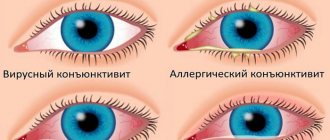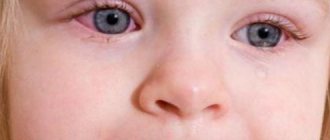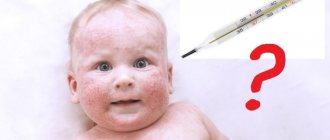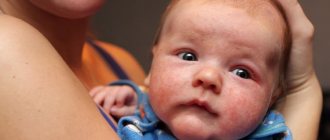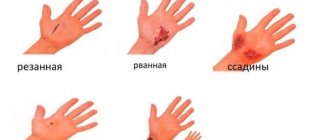Allergic reactions can occur in patients of different ages, such as newborns, schoolchildren and adolescents. For their treatment, antihistamines for children, produced in various pharmacological forms, are widely used. The choice of medications for allergies should only be made by a specialist, since any medication has indications, contraindications for use, and age restrictions.
Children's allergy medicine
In pediatric practice, allergy medications are used in the form of eye drops and nasal spray, suspensions, syrups, drops and tablets for oral administration, as well as solutions for inhalation. Pediatricians give preference to a specific dosage form, focusing on the type of allergy, its clinical manifestations and the general condition of the patient.
Antihistamines for allergies for children
Any antihistamine allergy medicine prescribed to children is designed to block histamine receptors (a biologically active substance produced by the body during an allergic reaction), stopping the allergic process.
All antihistamines are divided into old (first, second) and new (third and conditionally fourth) generations. Despite the presence of side effects in older generation antihistamines, they are still not used in pediatrics, even for the treatment of newborns, for the following reasons:
- rapid therapeutic effect;
- availability of parenteral forms of release;
- high antihistamine activity.
New generation antihistamines are practically not used for the treatment of infants, since there have not been enough studies to prove their safety in the treatment of children under 12 months. But these drugs also have a number of advantages:
- dosage regimen - 1 time per day;
- various forms of release;
- have a mild anti-inflammatory effect.
The new generation of drugs does not have a hypnotic or sedative effect, and is also quite easily tolerated.
First generation drugs can cause drowsiness, lethargy, acute urinary retention and dry mouth.
Allergy syrup for children
Allergy medicine in the form of syrup for children is a popular dosage form in pediatrics. Quite often, children are prescribed the following syrups:
- Erius. It contains the active ingredient desloratadine. Approved for use by children from one year of age. The syrup is taken orally 1 time per day, regardless of meals, with a small amount of water.
- Cetrilev. The active component of the drug is levocetirizine. Used to treat children from 2 years of age. Eating does not affect the absorption of the active substance, so the syrup can be taken at any time of the day, but no more than 1 time.
- Claritin. The active ingredient of the syrup is loratadine. The medicine is used to treat children from 2 years of age. The dosage is selected based on the patient’s weight category.
Young patients like their sweetish taste and fruity aroma, so they willingly take them, even if long-term use of the drug is required for hay fever or chronic urticaria.
The use of antiallergic drugs in the form of tablets
If children have already reached the age when they can freely swallow tablets, then oral antihistamines can be prescribed in any dosage form at the request of the patient or his parents. But, of course, there should be no age restrictions, and different tablets have their own:
- Claritin - from 3 years;
- Tsetrilev - from 6 years;
- Erius (coated tablets) - from 12 years of age.
In severe forms of allergies (intractable chronic urticaria, drug allergies in children, severe forms of atopy), in addition to antihistamine tablets, children can also be prescribed steroid drugs. If such a need arises, the doctor will tell you how and how much to take such medications.
Side effects
When using new generation antihistamines intended for external application, parents need to carefully ensure that the baby does not lick the hands and the medicine does not accidentally get into the eyes or onto the surface of mucous tissues.
Allergy drops from birth can only be used to treat one infant. This will help prevent further spread of the allergic process. An open bottle of medicine can be stored in accordance with the manufacturer's instructions, but not more than 2 weeks.
Some children may be bothered by increased dry mouth, stool disorders and attacks of nausea, constant tearfulness, headaches, and dizziness. In order to prevent the development of side effects, under no circumstances should you independently change the dosage of the drug prescribed by your doctor.
Drugs approved for use in infants and young children
Allergy medication used for newborns should be in the form of an injection or drops to take by mouth. For the treatment of small children, the following drugs are often used:
- Suprastin. It is available in the form of a solution for intravenous or intramuscular administration. Allowed to be used for newborns from 1 month.
- Pipolfen. This is a parenteral antiallergic drug. It contains the active ingredient promethazine. It is used to treat children older than 2 months.
- Fenistil. The drug is available in the form of oral drops and contains the active ingredient - dimethindene. They can be used in children from 1 to 12 months only after consulting a doctor.
- Cetrin. The drug in the form of drops based on cetirizine is approved for use in babies from 6 months.
Fenistil drops cannot be heated, so they should be added to a bottle of formula immediately before feeding. If the baby is already eating from a spoon, then they are simply dripped into a teaspoon and, without diluting, are allowed to be swallowed.
Any antihistamines are prohibited for use in premature infants or newborns less than 1 month old.
Types of allergies and their treatment
Medicine distinguishes several main types of allergic reactions depending on their manifestation:
Respiratory
Associated with the respiratory system, it most often manifests itself in certain seasons of the year, for example, in the spring - when plants are actively flowering. This allergy is called hay fever or seasonal rhinitis. For this diagnosis, antihistamine nasal drops are prescribed, such as Vibrocil, Sanorin.
Important! It is not difficult to distinguish an allergic reaction from a cold. The allergy does not cause an increase in temperature, and the mucus from the nose remains clear without changing its color to yellowish-green.
Allergic tracheitis
Allergic tracheitis (inflammation of the trachea due to allergens), often occurring in combination with rhinitis, is treated with Ketotifen, Fexofenadine, Cetirizine. Attacks of suffocation from allergic bronchial asthma are relieved by Berrotec and Salbutamol inhalers. They do not have a therapeutic effect, their effect is limited to the relief of unpleasant symptoms. An effective treatment regimen, depending on the severity of the disease, is prescribed by the doctor.
Skin allergies
Skin allergies are characterized by rashes on the skin and mucous membranes. For skin irritations, creams and ointments based on corticosteroid hormones are popular: hydrocortisone, Afloderm, Prednisolone, Beloderm, Advantan, Chalciderm. They are quickly absorbed into the blood and act systemically on the body.
Attention! Before the first application, do not neglect a skin test - apply a small amount to the inside of your hand anywhere closer to the palm, wait 15 minutes. In case of redness or itching, do not use the ointment; report the reaction to your doctor.
Food allergies
One of the first measures should be gastric lavage; if there is no vomiting, induce it. If more than an hour has passed, it is necessary to give a laxative and an enema. Sorbents, such as Carbolong, Smecta, Polysorb, Filtrum or activated carbon, will remove the allergen from the body. The effective dose of activated carbon is 1 tablet for every 10 kg of human weight.
For your information! Anti-allergy drugs should not be given together with a sorbent, as it will not allow the drug to be absorbed into the blood.
Drug allergy
Drug allergies manifest themselves both in a person predisposed to it, and in those who have never noticed an unwanted reaction. Failure to comply with the drug intake standards, leading to an overdose, a side effect of the drug, or the interaction of several medications can cause an allergic reaction in any person.
The most common unpleasant side effects are anti-seizure medications, antibiotics, non-steroidal anti-inflammatory drugs, and anesthetics (medicines administered for anesthesia).
| Reaction type name | Forms of manifestation | Allergen medications | Treatment |
| Anaphylactic (immediate) | Urticaria, bronchospasm, anaphylactic shock, angioedema (Quincke's edema), conjunctivitis, rhinitis, nausea, vomiting, diarrhea, abdominal pain | Preparations based on penicillin, sulfonamide, cephalosporins (a class of antibiotics), pyrazolones, muscle relaxants (drugs against muscle tone), vitamins, foreign serums (based on animal blood), etc. | 1. Discontinuation of the drug that caused the allergy. If there are several medications, you need to stop taking all of them. 2. Antihistamines in strict dosages according to age: tavegil, fenkarol or suprastin - twice a day; Kestin, Claritin or Zyrtec - once. 3. If there is no improvement after two days, prednisolone is given intramuscularly from 60 to 90 mg 4. It is possible to take glucocorticosteroids or corticosteroids. In case of anaphylactic shock or Quincke's edema - urgent hospitalization! |
| Cytotoxic | Allergic cytopenia (decrease in the blood of certain cells), hemolytic anemia (death of red blood cells in the blood), drug-induced lupus, glomerulonephritis (kidney damage) | Penicillin, hydralazine, quinidine, procainamide, phenytoin, methyldopa | |
| Immunocomplex | Arthus phenomenon (severe inflammation of the injection site, burning, itching), serum sickness (rash, swelling, fever due to an injected foreign protein), vasculitis (destruction and inflammation of blood vessels), agranulocytosis (decrease in leukocytes in the blood), drug fever, arthritis (inflammation joints) | Penicillin drugs, antibiotics, serums, vaccines, non-steroidal anti-inflammatory drugs, anesthetics (painkillers) | |
| Cell-mediated (slow) | Maculopapular rash (lumpy skin lesions), exfoliative dermatitis (flaking skin), erythroderma (skin lesions associated with redness and peeling in the form of large plates) | Chemicals, microbes, fungi and their spores, medicines |
Please note! If you notice a reaction to a certain medicine, be sure to report it! You need to avoid not only the drug itself, but also medications with similar chemical compounds! Thus, if you are allergic to acetylsalicylic acid, citramon and a number of anti-inflammatory non-steroidal drugs are contraindicated.
Food allergy medications for children
Medicines for food allergies in children are used in a complex manner. After stopping an allergic attack with broad-spectrum antihistamines, young patients are also prescribed medications from the following groups:
- Enterosorbents (Enterosgel, Atoxil, Smecta). They will help quickly remove allergens and their metabolites from the body.
- Probiotics (Hilak forte, Linux). Often food allergies are associated with a violation of the microflora of the digestive tract, so it is necessary to eliminate dysbiosis.
- Hepatoprotectors (Galstena, Karsil). If a small patient suffers from food allergies, this may indicate pathologies in the hepatobiliary region, so the baby may be prescribed medications to support the liver.
In addition, if food allergies occur, children are advised to drink plenty of fluids and switch to a hypoallergenic diet.
Dangers of self-prescribing for children
Selecting your own allergy medications for children, especially newborns, is very dangerous. Each baby’s body is individual and can react completely unpredictably to the medicine chosen by the parents. In addition, many antihistamines that work well for adults are not suitable for use by children under 12 years of age.
Only an experienced specialist, after carefully collecting anamnesis and conducting a series of tests, can prescribe suitable therapy for a small patient. But even in this case, it is possible that the baby will develop side effects or lack of effectiveness. Moreover, parents without medical education are unlikely to be able to choose the optimal remedy that would give a good result and not worsen the child’s condition.
Allergies are the scourge of modern society and a healthy lifestyle does not guarantee that this pathology will never develop in adults or young family members. But pharmacologists are constantly developing and improving drugs that allow both adult and young patients to cope with allergies. They should only be prescribed by those who are well versed in them - pediatricians, immunologists or allergists.
Important to remember
- In order for the allergic disease to recede, allergy pills are not bought by parents at the pharmacy themselves, but are prescribed by a specialist.
- Children are usually treated with antihistamine tablets (there are three generations of such drugs).
- Doctors recommend second-generation medications for therapy, and even better, third-generation ones.
- The new generation of allergy pills is actually completely safe and has a strong therapeutic result.
See you in the next article!

